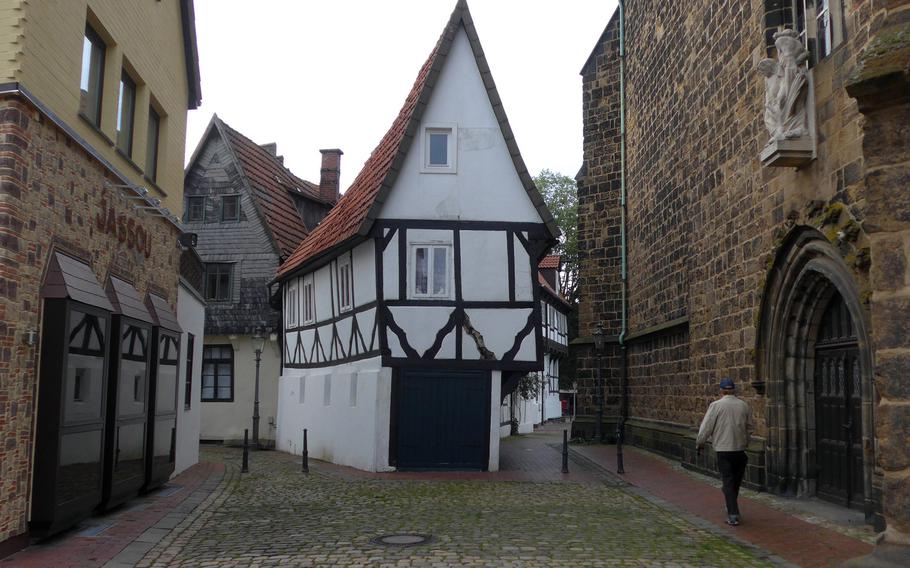
Hohestrasse in Minden, Germany, with an interestingly shaped half-timbered house at center and St. Martini Church on the right. A statue of St. Martin saving the beggar can be seen above the portal (Michael Abrams/Stars and Stripes)
On a recent assignment I spent a couple of nights in Minden, a northern German town on the Weser River.
After a long drive from Kaiserslautern, I checked into my hotel, grabbed my camera and went out to take a look at the town before the sun set.
Minden was first mentioned in Franconian annals in 798. Charlemagne founded the diocese of Minden just a couple of years later. Over the years it became a wealthy town, profiting from trade on the river. Today it feels a little economically depressed, but it’s filled with some interesting architecture, a cathedral, an old town hall and more.
Walking along the town’s cobblestone lanes, I passed the market square with its cafes and restaurants. A late burst of sunlight was shining on the upper part of the cathedral when I got there, but it was closed for the night.
The cathedral’s history dates to the 8th century; its Gothic nave was built in the 13th century. It was heavily damaged in World War II and rebuilt between 1948 and 1957.
The next day, after work, I continued my exploration, taking a path that led me to Minden’s upper town. Supported by an embankment that at some places is more than 20 feet high, it overlooks the lower town with the cathedral, market square and old town hall.
Up here is St. Martini church, where you can see a statue of the saint helping the beggar above one of the church’s portals.
There are also many interesting houses around here, especially on Ritterstrasse, where the Minden Museum occupies a row of stately old houses with a variety of facades. The museum features the 1,200-year history of the town, including a multimedia exhibit of the Minden as a 19th-century Prussian fortress.
Nearby is the Hansehaus, an imposing 16th-century building with a stepped gable.
Another old building is the 13th-century Alte Muenze, which was once possibly used as a mint.
The next morning, with the drive back to Kaiserslautern on the agenda, I woke up to a beautiful sunny sky. Heading out, I strolled past some of the places I had seen the days before, including the 16th-century Haus Hagemeyer. The two-color building is the town’s best example of Weser Renaissance, an architectural style that is found along the Weser River.
Snapping photos here and there I walked past the old town hall to the cathedral, which was now open, and went in. As plain as it is on the outside, the inside is beautiful. Soaring pillars support the Gothic hall, with light pouring in through stained-glass windows. The Golden Screen behind the altar is a copy — the original is in the Bode Museum in Berlin — as is the Mindener Crucifix. The original crucifix can be seen in the cathedral treasury across the street.
Less thrilling is the view when you come back out.
The town hall was built in 1260, destroyed in World War II and rebuilt in the 1950s. Unfortunately a modern monstrosity, which houses the town administration, was added, ruining the view and the medieval feeling.
It was time to head out.
Near Minden, crowning a hill above the Weser River valley is a monument dedicated to Emperor Wilhelm I. The Kaiser-Wilhelm-Denkmal, built between 1892 and 1896, is 280 feet tall and can be seen for miles above the valley. A narrow, winding road leads up to a parking lot; from there it is a short uphill stroll to the landmark.
I walked around the monument checking out the impressive almost 23-foot-high statue of Wilhelm looking out over the German countryside. Standing at the emperor’s feet, I joined him for the view.